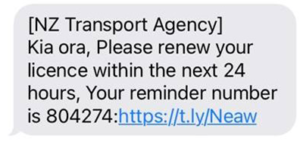Have you ever received a text message from your bank asking you to verify your account details? It’s a common tactic used by scammers to trick unsuspecting victims into revealing their personal information. The threat of cybercrime continues to grow. One of the most common types of cybercrime is SMS scams, In this article, we will explore how to identify SMS scams and the importance of reporting them to the Department of Internal Affairs via SMS 7726.
What is an text scam?
An SMS scam is a type of fraud that is carried out via text message. The goal of an SMS scam is to obtain sensitive information, such as banking details or personal identification numbers (PINs), or to convince the recipient to send money to the scammer. SMS scams are often designed to look like legitimate messages from banks, government agencies, or other trustworthy sources.
They may use urgent or threatening language to convince the recipient to act quickly, before they have time to think.
Common text Scams in NZ
Banking SMS asking you to sign in and verify
Toll Road SMS asking you to pay your toll
NZ Transport SMS asking you to pay your rego or a fine
Postal SMS asking you to pay a fee to release a package from customs
How to identify an SMS scam



There are several signs that an SMS message may be a scam. These include:
Urgency – Scammers often use language that creates a sense of urgency or fear, such as telling you that your account will be locked if you don’t take immediate action.
Requests for personal information – Scammers may ask you to provide personal information, such as your bank account details or social security number.
Requests for payment – Scammers may ask you to send money via wire transfer, cryptocurrency, or prepaid cards.
Suspicious links – Scammers may include links in their messages that lead to fake websites designed to steal your personal information.
Poor grammar or spelling – Scammers may use poor grammar or spelling, which can be a sign that the message is not legitimate.
Why should you report text scams?
Reporting SMS scams is an important step in preventing cybercrime. By reporting scams to the Department of Internal Affairs via SMS 7726.
You can help to identify and shut down fraudulent operations. Your report may also help to prevent others from falling victim to the same scam.
How to report text scams
To report an SMS scam to the Department of Internal Affairs, simply forward the message (Copy it, open a new message to 7726 and paste the message)
You will then receive a txt back asking what phone number the scam came from. The Department of Internal Affairs will review your report and take appropriate action.
Reporting the Sites that contain these scams
Sadly despite the Green Padlock that indicates “Secure” this site is far from it, masquerading as the real deal.
![]()

While we dont recommend visiting these sites on purpose, there is sometimes a benefit when you are confident in your ability to detect a scam.
The Google “Suspicious Site Reporter” is a browser extension that allows you to report suspicious websites directly to Google.
The tool is designed to help Google identify and block phishing and malware websites more quickly, thereby protecting internet users from potential harm.
When you report a website using the tool, Google will review the website and take appropriate action.
How to use the Google “Suspicious Site Reporter” tool

Using the Google “Suspicious Site Reporter” tool. Here’s how to do it:
1. Install the extension – The first step is to install the “Suspicious Site Reporter” extension for your browser.
You can download the extension from the Chrome Web Store, the Firefox Add-Ons page, or the Edge Add-Ons page.
2. Visit the suspicious website – Once you have the extension installed, visit the suspicious website that you want to report.
3. Click the extension icon – When you are on the suspicious website, click the “Suspicious Site Reporter” extension icon in your browser’s toolbar.
4. Report the site – In the pop-up window that appears, you can select the type of issue you are reporting, such as phishing or malware.
You can also include additional details, such as screenshots or a description of the problem.
5. Submit the report – After you have provided all the necessary information, click the “Submit” button to send your report to Google.
The result?
Google has a quick turnaround to these reports, they detect a increased number of reports and block that page from other users and informing new potential victims that the site is bad news. Protecting them from harm.
At the time of writing this article, asb-netcode.com has been taken down less than 24 hours after the report.
Conclusion
SMS scams are a common type of cybercrime that can be difficult to identify. However, by knowing the signs of an SMS scam and reporting any suspicious messages to the Department of Internal Affairs via SMS 7726, you can help to prevent others from falling victim to these fraudulent operations.
Remember to always be cautious when receiving unsolicited messages and never provide personal information or send money to someone (or a website) you don’t know.
